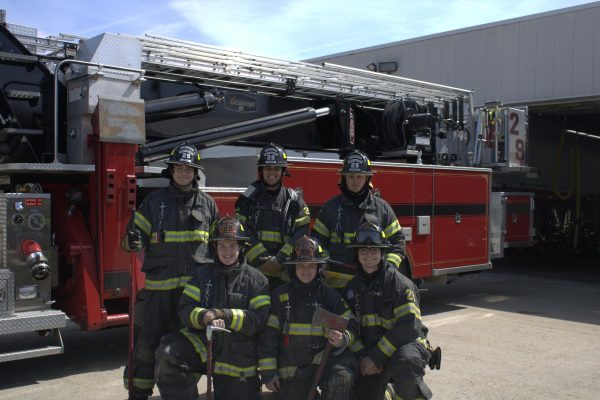‘Pet Sematary’: King’s horror fails on screen
Amidst the resurgence of horror author Stephen King’s popularity after the success of “It,” “Pet Sematary,” the latest in King’s book-to-film adaptations, seemed destined to be the newest addition in Hollywood’s horror movie renaissance. With celebrated actors like Jason Clarke and John Lithgow in the lead roles — and an updated, more realistic version of the demonic cat Church — the “Pet Sematary” remake could have been the next big thing.
Instead, the film ends as quietly as it begins, with tense moments peppered sparsely in between.
One of the most impressive scenes of the film is its opening shot. A sweeping aerial view of the idyllic town in which the main characters live pans slowly to a shocking contrast: blood smeared on the window of a truck while fire consumes a farmhouse just behind the car. The image is abrupt and jarring, and it promises the plot will build slowly to the disaster on screen.
As the fire and blood fade away, “Pet Sematary” jumps back in time a few months to introduce the main characters, who are moving into their new farmhouse in an effort to slow down and grow as a family. Louis, played by Clarke, works for a local clinic, while his wife, Rachel, played by Amy Seimetz, stays home to take care of their two young children. Here, the film does a wonderful job of building the atmospheric tension, from the genuinely disturbing setting of the small, rural town, to the pet “sematary,” a cemetery where locals bury their dead animals.
Just as it does in the opening scene, “Pet Sematary” again promises local terror with the introduction of what appears to be a cult of mask-wearing animal mourners — and again, it’s a promise the film does not quite fulfill. The mask designs, all crudely based on real animals, are horrific, and the slow procession of the cult into the forest is frightening, especially since Rachel and Louis can do nothing but watch as the group winds its way through their property. The cult is eventually revealed to be visiting the pet cemetery, but after that, they are almost never seen nor mentioned again.
After watching the cult visit the cemetery, Louis and Rachel’s young daughter Ellie, played by Jeté Laurence, decides to explore the woods herself and, upon finding the cemetery, begins to climb the tall wall surrounding the graves. Lithgow’s local expert Jud interrupts her, but not before she shatters a few of the sticks that make up the wall. Once more, “Pet Sematary” indicates that there is something deeply wrong and dangerous with Ellie breaking a few sticks, but the film never fully expands on the idea.
The scene does, however, introduce one of the film’s greatest features — Lithgow’s Jud. From the moment he steps on screen, Jud is entirely believable as an exhausted, kind, old man who has spent his entire life battling the temptations and fear radiating from the forest’s heart. Instead of acting as the sinister and mysterious local who only contributes to the new family’s sense of discomfort, Jud is a caring figure, and he contributes to the dark, atmospheric tone that pervades “Pet Sematary.” He is, undoubtedly, one of the brightest spots in the film.
As Ellie introduces Jud to the family and he begins to spend more and more time with them, Louis has a tragic day at the clinic when a young man is rushed to his care. After being hit by one of the semi trucks constantly shown speeding down local roads, Victor Pascow (Obssa Ahmed) is barely alive while Louis tries to stop his bleeding and close his head wound, which has exposed his brain. The gore effects are impressive, and they add a new level of suspense to the otherwise quiet film. When Pascow dies before receiving any significant treatment, Louis hallucinates the young man’s body reanimating long enough to give him a warning about the barrier being broken, presumably when Ellie slipped on the wall.
Trying to ignore his hallucination, Louis leaves work, and his life gradually returns to normal — save for vivid nightmares he has of following a still-disfigured Pascow past the pet cemetery and deeper into the forest.
Rachel, meanwhile, slowly spirals deeper into her own mind as she remembers her sister Zelda, whom she accidentally caused to fall down a dumbwaiter and snap her neck when she was still a child. Although Zelda had severe physical deformities and often threatened Rachel out of bitterness, Rachel continues to feel guilty for her death.
While both parents struggle to cope with their nightmares and internal fears, Church, the family cat, is hit and killed by one of the ever-present semi trucks. Unable to handle death after Zelda, Rachel begs Louis to pretend the cat ran away to avoid breaking Ellie’s heart, but as Louis prepares to bury Church, Jud offers him another solution. In an obnoxiously vague manner, Jud leads Louis to sacred ground far past the pet cemetery and instructs him to bury Church. Despite his confusion, Louis complies and, the next morning, is shocked to find Church alive, with bloody, matted fur and an angry demeanor.
Jud reveals the sacred ground brings animals and people back to life, but each creature comes back different than before they died — each creature is angrier and far more dangerous. Louis comes to terms with this information in a startlingly short amount of time, though his nightmares of Pascow grow worse. After Pascow delivers a warning to stay away from the forest, Louis finds Church’s new, cruel personality unbearable, and he sets the cat free in the forest, just before Ellie’s ninth birthday.
During Ellie’s birthday party, the girl, heartbroken over Church’s disappearance, wanders into the middle of the road when she thinks she sees her lost cat. Her three-year-old brother Gage follows and, as another semi truck bears down on both children, Louis leaps onto the road in time to save Gage — but he fails to stop the truck from killing Ellie.
Distraught over the loss of her daughter, Rachel takes Gage to her parents’ home, making Louis promise he will follow them soon after. Louis, alone in his house, spirals further into madness and desperation, and he digs up Ellie’s body to bury it on the sacred ground in the forest, despite Jud’s warnings. The ground, according to Jud, poisons the mind and soul of each person who visits, toying with anxieties and depression until that person decides to visit again. Ignoring the change he saw in Church, Louis brings Ellie back to life, only to find himself faced with a demonic girl who only resembles Ellie physically, with Church appearing once more to stay close by Ellie’s side.
Up until the moment Ellie dies, Laurence is only a half-convincing child actress whose lines seem more forced than any other character’s in the film. Once she is resurrected, however, Laurence’s skill is palpable, from her cold, blank stares to her uncontrollable rage. She dominates each scene she is in, switching seamlessly from a hellish, inhuman creature to a mockery of a sweet girl.
Ellie grows angrier and crueler until, when Rachel returns home with Gage and Jud begs Louis to fix her mistake, she begins to murder each person who wants her to be killed. Working with Church, Ellie sneaks into Jud’s house and, after a breathless scene of cat-and-mouse, stabs him to death. When she returns to the house to reunite with her horrified mother, Ellie promptly murders Rachel after realizing Rachel wants nothing to do with her.
In an attempt to save what’s left of his family, Louis locks Gage in the truck from the beginning of the film and runs after Ellie, who drags Rachel into the forest to resurrect her. The film’s most emotional moment, and one of its best, comes when Louis realizes he must kill Ellie because she is no longer his daughter. His pain and horror bleed into his expression, while Laurence’s acting as the infuriated creature bolsters the scene, but before Louis can kill Ellie with a shovel, the now-resurrected Rachel kills him. Together, Ellie and Rachel resurrect Louis, and the undead family returns to the house to, presumably, do the same to Gage before the film ends abruptly.
Although “Pet Sematary” uses an atmospheric tone to instill an impressive amount of unease and dread throughout the first part of the film, its climax happens so quickly that there is no satisfaction in connecting the final scene with the first. Too much time is spent on Church’s changed behavior that Ellie is resurrected, revealed to be a murderous demon and triumphant in only a few minutes.
While the audience watches in painstaking detail how the sacred ground changes Church and Ellie, “Pet Sematary” never develops one of the most interesting parts of its mythos: the idea that the sacred ground manipulates people’s emotions. After the death of Ellie, Louis essentially becomes a puppet for the sacred ground’s powers, but the manipulation of his grief and horror is hardly mentioned. The film’s plodding pace never reaches a satisfying climax, and it has several plot points — from the rich backstory with Rachel and Zelda to Pascow’s warning of the broken barrier — that are simply abandoned.
“Pet Sematary” certainly isn’t a bad movie, but in a new age of appreciation for King’s masterful work, horror fans deserve so much more.

Lauren Trimber is a senior majoring in English and creative writing and minoring in political science. This is her third year on staff, and she will be...






